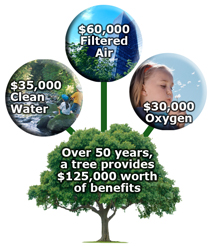Forest Facts

New Jersey’s forests
- New Jersey is 42 percent forested.
- 62 percent of New Jersey’s forests are privately owned.
- Forests are the greatest land use in New Jersey.
- The Northern Red Oak Quercus rubra is the New Jersey state tree.
- New Jersey has one of the most vivid displays of fall foliage that rivals those of forests anywhere else in the world. Peak season starts in early October.
- The Flowering Dogwood Cornus florida is the New Jersey state memorial tree.
New Jersey Forest Management Facts
- New Jersey has 166 towns and cities designated as a “Tree City USA.”
- NJ has more than 300 Tree Farms managing over 92,000 acres.
- There is approximately 775,000 acres of state-owned open space in New Jersey.
- 4,479 New Jersey woodland owners are enrolled in Farmland Assessment resulting in 227,438 total acres of forests under active management.
- 1,040 participants enrolled in Forest Stewardship Program, covering 115,019 acres of NJ forest land.
- More than 50 percent of New Jersey communities either have or are working on a Community Forestry Management Plan.
- The New Jersey Forest Nursery produces 300,000 seedlings yearly at a low cost for all New Jersey residents.
New Jersey’s Unique Forested Areas
- Roughly 70 percent of the Highlands region in New Jersey is forested. Each year over 20 million people visit the Highlands scenic mountains and waterways for recreation activities such as hiking, biking, canoeing, and fishing.
- The New Jersey Pine Barrens or Pinelands covers over one million acres of the Outer Coastal Plain in southern and central New Jersey. This unique environment supports stands of valuable Atlantic White Cedar and the endangered Pine Barrens Tree Frog. 45 percent of the Pinelands is publically-owned.
- The Natural Heritage Database contains more than 11,000 records of locations in New Jersey for rare plants, animals, and ecological communities.
Forest Benefits
- Forests support up to 90 percent of known terrestrial species.
- Forests are biologically diverse systems, representing some of the richest biological areas on Earth. They offer a variety of habitats for plants, animals and micro-organisms.
- One acre of forest absorbs six tons of carbon dioxide and puts out four tons of oxygen. This is enough to meet the annual needs of 18 people.
- During a heavy rain, a healthy forest can absorb as much as 20,000 gallons of water in an hour.

Tree Benefits
- In laboratory research, visual exposure to settings with trees has produced significant recovery from stress within five minutes, as indicated by changes in blood pressure and muscle tension.
- The "heat island" effect makes temperatures 3 to 10 degrees warmer in cities than the surrounding countryside. These islands result from storage of thermal energy in concrete, steel and asphalt. The collective effect of a large area of transpiring trees reduces the air temperature in those areas.
- Trees help reduce the greenhouse effect by directly absorbing CO2 - the primary greenhouse gas - from the atmosphere during photosynthesis. Trees also shade buildings which reduces air conditioning use, resulting in reduced amounts of CO2 emitted by power plants.
- Trees help to conserve soil and water, control avalanches, prevent desertification, protect coastal areas and stabilize sand dunes.
- Customers are willing to pay as much as 10 percent more for certain goods and services if businesses are located on tree-lined streets.
- Healthy trees can add up to 15 percent to residential property value.
- Planting a tree is an inexpensive and effective means of drawing excess CO2 from the atmosphere.
- About 500 full-sized trees are required to absorb the carbon dioxide produced by a typical car driven 12,000 miles per


 You are here:
You are here: